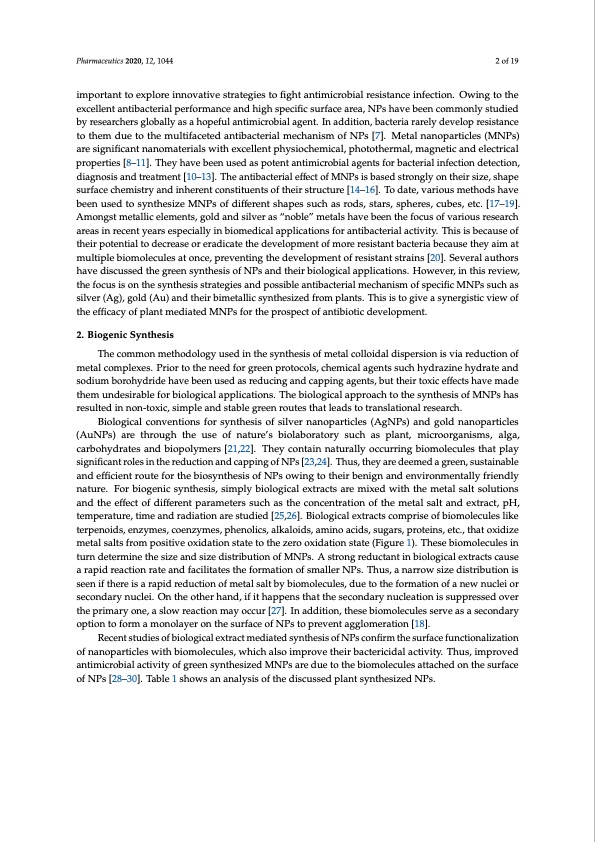
PDF Publication Title:
Text from PDF Page: 002
Pharmaceutics 2020, 12, 1044 2 of 19 important to explore innovative strategies to fight antimicrobial resistance infection. Owing to the excellent antibacterial performance and high specific surface area, NPs have been commonly studied by researchers globally as a hopeful antimicrobial agent. In addition, bacteria rarely develop resistance to them due to the multifaceted antibacterial mechanism of NPs [7]. Metal nanoparticles (MNPs) are significant nanomaterials with excellent physiochemical, photothermal, magnetic and electrical properties [8–11]. They have been used as potent antimicrobial agents for bacterial infection detection, diagnosis and treatment [10–13]. The antibacterial effect of MNPs is based strongly on their size, shape surface chemistry and inherent constituents of their structure [14–16]. To date, various methods have been used to synthesize MNPs of different shapes such as rods, stars, spheres, cubes, etc. [17–19]. Amongst metallic elements, gold and silver as “noble” metals have been the focus of various research areas in recent years especially in biomedical applications for antibacterial activity. This is because of their potential to decrease or eradicate the development of more resistant bacteria because they aim at multiple biomolecules at once, preventing the development of resistant strains [20]. Several authors have discussed the green synthesis of NPs and their biological applications. However, in this review, the focus is on the synthesis strategies and possible antibacterial mechanism of specific MNPs such as silver (Ag), gold (Au) and their bimetallic synthesized from plants. This is to give a synergistic view of the efficacy of plant mediated MNPs for the prospect of antibiotic development. 2. Biogenic Synthesis The common methodology used in the synthesis of metal colloidal dispersion is via reduction of metal complexes. Prior to the need for green protocols, chemical agents such hydrazine hydrate and sodium borohydride have been used as reducing and capping agents, but their toxic effects have made them undesirable for biological applications. The biological approach to the synthesis of MNPs has resulted in non-toxic, simple and stable green routes that leads to translational research. Biological conventions for synthesis of silver nanoparticles (AgNPs) and gold nanoparticles (AuNPs) are through the use of nature’s biolaboratory such as plant, microorganisms, alga, carbohydrates and biopolymers [21,22]. They contain naturally occurring biomolecules that play significant roles in the reduction and capping of NPs [23,24]. Thus, they are deemed a green, sustainable and efficient route for the biosynthesis of NPs owing to their benign and environmentally friendly nature. For biogenic synthesis, simply biological extracts are mixed with the metal salt solutions and the effect of different parameters such as the concentration of the metal salt and extract, pH, temperature, time and radiation are studied [25,26]. Biological extracts comprise of biomolecules like terpenoids, enzymes, coenzymes, phenolics, alkaloids, amino acids, sugars, proteins, etc., that oxidize metal salts from positive oxidation state to the zero oxidation state (Figure 1). These biomolecules in turn determine the size and size distribution of MNPs. A strong reductant in biological extracts cause a rapid reaction rate and facilitates the formation of smaller NPs. Thus, a narrow size distribution is seen if there is a rapid reduction of metal salt by biomolecules, due to the formation of a new nuclei or secondary nuclei. On the other hand, if it happens that the secondary nucleation is suppressed over the primary one, a slow reaction may occur [27]. In addition, these biomolecules serve as a secondary option to form a monolayer on the surface of NPs to prevent agglomeration [18]. Recent studies of biological extract mediated synthesis of NPs confirm the surface functionalization of nanoparticles with biomolecules, which also improve their bactericidal activity. Thus, improved antimicrobial activity of green synthesized MNPs are due to the biomolecules attached on the surface of NPs [28–30]. Table 1 shows an analysis of the discussed plant synthesized NPs.PDF Image | Bactericidal Antibacterial Mechanism of Plant Nanoparticles

PDF Search Title:
Bactericidal Antibacterial Mechanism of Plant NanoparticlesOriginal File Name Searched:
pharmaceutics-12-01044-v2.pdfDIY PDF Search: Google It | Yahoo | Bing
Turbine and System Plans CAD CAM: Special for this month, any plans are $10,000 for complete Cad/Cam blueprints. License is for one build. Try before you buy a production license. More Info
Waste Heat Power Technology: Organic Rankine Cycle uses waste heat to make electricity, shaft horsepower and cooling. More Info
All Turbine and System Products: Infinity Turbine ORD systems, turbine generator sets, build plans and more to use your waste heat from 30C to 100C. More Info
CO2 Phase Change Demonstrator: CO2 goes supercritical at 30 C. This is a experimental platform which you can use to demonstrate phase change with low heat. Includes integration area for small CO2 turbine, static generator, and more. This can also be used for a GTL Gas to Liquids experimental platform. More Info
Introducing the Infinity Turbine Products Infinity Turbine develops and builds systems for making power from waste heat. It also is working on innovative strategies for storing, making, and deploying energy. More Info
Need Strategy? Use our Consulting and analyst services Infinity Turbine LLC is pleased to announce its consulting and analyst services. We have worked in the renewable energy industry as a researcher, developing sales and markets, along with may inventions and innovations. More Info
Made in USA with Global Energy Millennial Web Engine These pages were made with the Global Energy Web PDF Engine using Filemaker (Claris) software.
Infinity Turbine Developing Spinning Disc Reactor SDR or Spinning Disc Reactors reduce processing time for liquid production of Silver Nanoparticles.
| CONTACT TEL: 608-238-6001 Email: greg@infinityturbine.com | RSS | AMP |